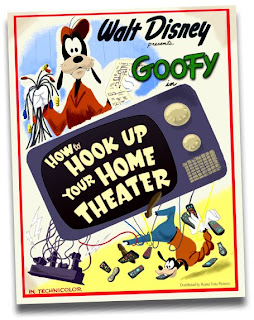 Wall-E doesn't play by the rules. I refer to Wall-E the film as opposed to Wall-E the character.
Wall-E doesn't play by the rules. I refer to Wall-E the film as opposed to Wall-E the character.While it seems that praise has been nearly universal for this latest Pixar film, a considerable amount of dialog has emerged about what many consider the movie's somewhat odd mixture of formats. Specifically, the initial presentation of photo-realistic characters and environments, the use of live-action footage (primarily in the scenes featuring actor Fred Willard) and the somewhat dramatic aesthetic shift to the more cartoony realizations of the human beings aboard the Axiom spaceship in the film's latter half.
Noted animator and animation historian Michael Sporn noted on his blog, "I was, again, impressed with the incredible artistic abilities of the Pixar people, but I didn’t feel as though I were watching an animated film. It felt like a live action film (until the balloony fat people entered) with high effects. Perhaps that’s a positive; I’m not sure anymore. Pinocchio, Bambi, Dumbo, Snow White. These films were magic to me as a child. I imagine Wall-E is like every other effects film to today’s children. I can’t imagine it will inspire future generations to get into the field. Maybe, you never know."
I agree with Michael; very often over the course of Wall-E's 97 minutes, I completely lost the sense of this being an animated film. In fact, so immersed was I in this environment that, when EVE ignited a cigarette lighter in one of the movie's earlier scenes and my friend next to me marveled at how the flame was a simple yet amazing piece of animation, it took me a moment to understand what he was talking about. And I understand Michael's reservations as well. With much of Wall-E, Pixar has stepped beyond the very genre it has espoused and remained generally faithful to over the course of its prior eight films. They clearly decided to, in many aspects, move beyond what would be considered a traditional animated presentation. To many, especially industry professionals like Michael, it begs the question--are we watching something akin to Pinocchio or Snow White, or product more related to George Lucas' FX-driven opuses, or blue screen-filmed dynamics like Sky Captain and the World of Tomorrow and 300?
I believe the answer to that question is truly rooted in the out-of-box creative approach that Pixar has long been noted for. Wall-E is unconventional. It moves beyond the unwritten but still somewhat ingrained rules of animation presentation, and does so in the service of the story it wishes to tell. I submit that the combination of the film's disjointed aesthetic dynamics was very much a deliberate choice on the part of Andrew Stanton and his team. The movie's three very distinct design approaches--photo-realistic animation, live-action actors and sets, and cartoon-based characters--are in fact integral components of the film's overall theme and story.
While Wall-E is at its heart a character-driven love story, it is played out on a thematic canvas that contrasts reality with the artificial. Robots are artificial; that is and has been a consistent truism of all entertainment media. And typically accompanying that truism is the story device of imbuing robots with sentience and emotions. But that plot dynamic is in fact not really central to Wall-E. Wall-E is introduced as a fully developed personality, not requiring a journey of self-discovery. He is a survivor very aware of his harsh reality, a being who understands concepts of loyalty and friendship, and more than anything he is a lonely dreamer yearning for companionship. Though artificial in construct, Wall-E is very real; he is not very far removed from current executions of robot-based technology, thus he is all the more believable. In turn, his native environment is equally believable; from the haunting landscapes of an abandoned and garbage-filled megalopolis, right down to his battered Rubik's Cube and comical collection of garden gnomes. The intention becomes clear, Wall-E's world is not very far removed from our own.
The establishment of Wall-E and his environment by use of photo-realistic animation then serves to contrast the film's other not so subtle overriding theme--the reverse-evolution of humanity. Closeted aboard a giant cruise ship-inspired spacecraft, the human race has wholly embraced the artificial. Theirs is an existence of commercial over-consumption, supported by an infrastructure that simultaneously exposes and insulates them from their environment and fellow beings. The physical-emotional connectivity that Wall-E so desperately desires is seemingly always within reach for the denizens of the Axiom, but ironically only occurs by accident.
In filmed entertainment, there is in fact nothing more artificial than traditional cartoon-style animation. And so we thus see that transformation of human beings in the film. Humanity, as initially represented by the very real character of Buy-N-Large CEO Shelby Forthright, portrayed by Willard, is ultimately supplanted by the very artificial and cartoon style-designed incarnations aboard the Axiom. It is an evolution that is cleverly documented via the portraits of the Axiom Captains that hang on the wall in the current ship captain's quarters. It is there in that one subtle but very important set piece that the filmmakers' aesthetic and design intentions become especially clear.
Characteristic of Pixar, it is indeed a bold move. For they in fact use the various different formats of filmed presentation in the service of storytelling and transcend the very medium they have long been associated with. In many circles, especially those within the animation industry, it will likely remain a debated and somewhat controversial topic. As strictly a moviegoer, for me, Wall-E presented a wholly new and original approach to the animation genre. We can certainly split hairs as to how we want to categorize and classify the film, but in the end, at least in my opinion, it will remain a wonderful combination of stunning visuals and heartfelt storytelling.
Image © Walt Disney Company





















































